Numerical Modeling of Nearshore Wave Transformation and Breaking Processes in the Yellow River Delta with FUNWAVE-TVD Wave Model
Abstract
:1. Introduction
2. Methodology
2.1. Study Area and Data Sources
2.2. Numerical Model
2.2.1. Wave Generation
2.2.2. Wave-Breaking Treatment
2.2.3. Model Configuration
2.3. Skill Assessment of Depth Model
3. Results and Discussion
3.1. Energy Spectra Analysis
3.2. Coherence Analysis
4. Conclusions
- (1)
- Among several public satellite-based databases, the Copernicus DEM database (GLO-30) can provide 30 m resolution cell-centered grid elevation data that cover the modern topography of the YRD. Despite delivering high-quality bathymetry data with high resolution (~50 m), the latest version of GMRT (v4.0) cannot provide accurate water depths near the modern coastline of the YRD. Therefore, the derived depth data from the Chinese nautical chart at the YRD are considered to obtain accurate bathymetry at a desirable resolution, as the interpolated bathymetry is not only in good agreement with satellite-based data but also displays smooth morphologies from the offshore to the modern coastline regions, which could benefit the model simulation.
- (2)
- The newly proposed wave model is a suitable approach for investigating the impact of topography on wave dynamics because it can exclude coherency effects on the longshore variability of wave propagation. The generated waves with higher coherencies exhibited stronger variations in magnitude. In addition, the 1800 s averaging period of wave statistics is an applicable parameter for obtaining quality results, as in small degrees of coherence, a shorter time interval would present a higher variation in significant wave height. Additionally, the most constant spatial distribution of wave height was observed for waves with BDBF energy propagating across the domain. Although there was no difference between situations with broad and narrow frequency spreading, the vorticity increased noticeably when the wavemaker energy switched from narrow to broad directional spreading. The absence of coherent waves caused consistently distributed vorticity in the region with mostly positive values.
- (3)
- The influence of morphological changes on the wave height in the YRD is easily discernible by comparing the results with and without coherency effects, as the waves gradually dissipated when propagating toward the coastline and reduced by approximately 50% of their height (from approximately 0.4 to 0.2 m) at a water depth of 5–6 m (approximately 3–4 km away from the wavemaker). Additionally, the standard deviation of the wave height decreased when waves propagated close to the shoreline and grew as they approached the breaker zone (X 8000 m) in the northern half of the domain (from Y = 10,000 m and above) and decreased when waves propagated close to the shoreline at water depth of 1 m (X ≈ 6000 m) and below. The cross-shore current velocity decreases as waves move towards the surf zone of the research area, where the water depths are between 1 and 5 m, while the vorticity accelerated, indicating a higher shear wave magnitude. In the present work, time-varying snapshots of the maximum vorticity are used to efficiently identify the location of the surf and breaker zones in the YRD because the breaking of individual random waves produces a high vorticity.
- (4)
- Regarding energy dissipation, the analyzed degrees of wave coherence do not differ significantly in terms of energy loss, although the case of 100% coherence has a marginally lower energy loss than the other cases. In the YRD, the simulated wave dissipated more than 60% of its energy when it reached a depth of less than 5 m, more than 80% when propagated to a depth of less than 2 m, and completely dissipated the energy when it broke at the shoreline.
Author Contributions
Funding
Data Availability Statement
Acknowledgments
Conflicts of Interest
References
- Klingbeil, K.; Lemarié, F.; Debreu, L.; Burchard, H. The numerics of hydrostatic structured-grid coastal ocean models: State of the art and future perspectives. Ocean Model. 2018, 125, 80–105. [Google Scholar] [CrossRef] [Green Version]
- Reeve, D.E.; Chadwick, A.J.; Fleming, C.A. Coastal Engineering-Processes, Theory, and Design Practice, 3rd ed.; Taylor & Francis: London, UK; CRC Press: Boca Raton, FL, USA, 2018. [Google Scholar]
- Feagin, R.A.; Sherman, D.J.; Grant, W.E. Coastal erosion, global sea-level rise, and the loss of sand dune plant habitats. Front. Ecol. Environ. 2005, 3, 359–364. [Google Scholar] [CrossRef]
- Nicholls, R.J.; Hoozemans, F.M.J.; Marchand, M. Increasing flood risk and wetland losses due to global sea-level rise: Regional and global analyses. In Global Environmental Change; Elsevier Ltd.: Amsterdam, The Netherlands, 1999; pp. S69–S87. [Google Scholar] [CrossRef]
- Fu, Y.; Guo, Q.; Wu, X.; Fang, H.; Pan, Y. Analysis and prediction of changes in coastline morphology in the Bohai Sea, China, using remote sensing. Sustainability 2017, 9, 900. [Google Scholar] [CrossRef] [Green Version]
- Mao, M.; van der Westhuysen, A.J.; Xia, M.; Schwab, D.J.; Chawla, A. Modeling wind waves from deep to shallow waters in Lake Michigan using unstructured SWAN. J. Geophys. Res. 2016, 121, 3836–3865. [Google Scholar] [CrossRef]
- Janssen, P. The Interaction of Ocean Waves and Wind; Cambridge University Press: Cambridge, UK, 2004. [Google Scholar] [CrossRef] [Green Version]
- Mao, M.; Xia, M. Wave–current dynamics and interactions near the two inlets of a shallow lagoon–inlet–coastal ocean system under hurricane conditions. Ocean Model. 2018, 129, 124–144. [Google Scholar] [CrossRef]
- Longley, K.E. Wave Current Interactions and Wave-Blocking Predictions Using Nhwave Model. Ph.D. Thesis, Naval Postgraduate School, Monterey, CA, USA, 2013; p. 61. [Google Scholar]
- Ting, F.C.K. Laboratory study of wave and turbulence characteristics in narrow-band irregular breaking waves. Coast. Eng. 2002, 46, 291–313. [Google Scholar] [CrossRef]
- Duran, A.; Richard, G.L. Modelling coastal wave trains and wave breaking. Ocean Model. 2020, 147, 101581. [Google Scholar] [CrossRef]
- Gao, J.; Ji, C.; Gaidai, O.; Liu, Y.; Ma, X. Numerical investigation of transient harbor oscillations induced by N-waves. Coast. Eng. 2017, 125, 119–131. [Google Scholar] [CrossRef]
- Gao, J.; Ma, X.; Zhang, J.; Dong, G.; Ma, X.; Zhu, Y.; Zhou, L. Numerical investigation of harbor oscillations induced by focused transient wave groups. Coast. Eng. 2020, 158, 103670. [Google Scholar] [CrossRef]
- Gao, J.; Ma, X.; Dong, G.; Chen, H.; Liu, Q.; Zang, J. Investigation on the effects of Bragg reflection on harbor oscillations. Coast. Eng. 2021, 170, 103977. [Google Scholar] [CrossRef]
- Liu, C.; Onat, Y.; Jia, Y.; O’Donnell, J. Modeling nearshore dynamics of extreme storms in complex environments of Connecticut. Coast. Eng. 2021, 168, 103950. [Google Scholar] [CrossRef]
- Qu, K.; Sun, W.Y.; Deng, B.; Kraatz, S.; Jiang, C.B.; Chen, J.; Wu, Z.Y. Numerical investigation of breaking solitary wave runup on permeable sloped beach using a nonhydrostatic model. Ocean Eng. 2019, 194, 106625. [Google Scholar] [CrossRef]
- Johnson, D.; Pattiaratchi, C. Boussinesq modelling of transient rip currents. Coast. Eng. 2006, 53, 419–439. [Google Scholar] [CrossRef]
- Dalrymple, R.A.; MacMahan, J.H.; Reniers, A.J.H.M.; Nelko, V. Rip currents. Annu. Rev. Fluid Mech. 2011, 43, 551–581. [Google Scholar] [CrossRef]
- Janssen, T.T.; Herbers, T.H.C. Nonlinear wave statistics in a focal zone. J. Phys. Oceanogr. 2009, 39, 1948–1964. [Google Scholar] [CrossRef]
- Dalrymple, R.A. A Mechanism for Rip Current Generation on an Open Coast. J. Geophys. Res. 1975, 80, 3485–3487. [Google Scholar] [CrossRef]
- Smit, P.B.; Bland, R.; Janssen, T.T.; Laughlin, B. Remote sensing of nearshore wave interference. J. Geophys. Res. 2016, 121, 3010–3028. [Google Scholar] [CrossRef] [Green Version]
- Chawla, A.; Özkan-Haller, H.T.; Kirby, J.T. Spectral Model for Wave Transformation and Breaking over Irregular Bathymetry. J. Waterw. Port Coast. Ocean Eng. 1998, 124, 189–198. [Google Scholar] [CrossRef]
- Dalrymple, R.A.; Lanan, G.A. Beach cusps formed by intersecting waves. Geol. Soc. Am. Bull. 1976, 87, 57–60. [Google Scholar] [CrossRef]
- Wei, Z.; Dalrymple, R.A. SPH Modeling of Short-crested Waves. arXiv 2017, arXiv:1705.08547. [Google Scholar]
- Spydell, M.; Feddersen, F. Lagrangian drifter dispersion in the surf zone: Directionally spread, normally incident waves. J. Phys. Oceanogr. 2009, 39, 809–830. [Google Scholar] [CrossRef]
- Farahani, R.J.; Dalrymple, R.A.; Hérault, A.; Bilotta, G.; Rustico, E. Modeling the coherent vortices in breaking waves. In Proceedings of the 9th Internal SPHERIC Workshop, Paris, France, 3–5 June 2014. [Google Scholar]
- Zhang, S.; Zhu, L.; Zou, K. A Comparative Study of Numerical Models for Wave Propagation and Setup on Steep Coral Reefs. China Ocean Eng. 2019, 33, 424–435. [Google Scholar] [CrossRef]
- Smit, P.B.; Janssen, T.T. The evolution of inhomogeneous wave statistics through a variable medium. J. Phys. Oceanogr. 2013, 43, 1741–1758. [Google Scholar] [CrossRef] [Green Version]
- Janssen, T.T.; Herbers, T.H.C.; Battjes, J.A. Evolution of ocean wave statistics in shallow water: Refraction and diffraction over seafloor topography. J. Geophys. Res. 2008, 113, 1–12. [Google Scholar] [CrossRef] [Green Version]
- Smit, P.B.; Janssen, T.T.; Herbers, T.H.C. Stochastic modeling of coherent wave fields over variable depth. J. Phys. Oceanogr. 2015, 45, 1139–1154. [Google Scholar] [CrossRef] [Green Version]
- Smit, P.B.; Janssen, T.T.; Herbers, T.H.C. Stochastic modeling of inhomogeneous ocean waves. Ocean Model. 2015, 96, 26–35. [Google Scholar] [CrossRef]
- Smit, P.B.; Janssen, T.T. The evolution of nonlinear wave statistics through a variable medium. J. Phys. Oceanogr. 2016, 46, 621–634. [Google Scholar] [CrossRef]
- Akrish, G.; Smit, P.; Zijlema, M.; Reniers, A. Modelling statistical wave interferences over shear currents. J. Fluid Mech. 2020, 891, A2. [Google Scholar] [CrossRef] [Green Version]
- Shi, F.; Kirby, J.T.; Harris, J.C.; Geiman, J.D.; Grilli, S.T. A high-order adaptive time-stepping TVD solver for Boussinesq modeling of breaking waves and coastal inundation. Ocean Model. 2012, 43–44, 36–51. [Google Scholar] [CrossRef]
- Liu, Z.; Fang, K.; Cheng, Y. A new multi-layer irrotational Boussinesq-type model for highly nonlinear and dispersive surface waves over a mildly sloping seabed. J. Fluid Mech. 2018, 842, 323–353. [Google Scholar] [CrossRef]
- Liu, W.; Liu, Y.; Zhao, X. Numerical study of Bragg reflection of regular water waves over fringing reefs based on a Boussinesq model. Ocean Eng. 2019, 190, 106415. [Google Scholar] [CrossRef]
- Liu, W.; Ning, Y.; Shi, F.; Sun, Z. A 2DH fully dispersive and weakly nonlinear Boussinesq-type model based on a finite-volume and finite-difference TVD-type scheme. Ocean Model. 2020, 147, 101559. [Google Scholar] [CrossRef]
- Ma, G.; Kirby, J.T.; Hsu, T.J.; Shi, F. A two-layer granular landslide model for tsunami wave generation: Theory and computation. Ocean Model. 2015, 93, 40–55. [Google Scholar] [CrossRef] [Green Version]
- Zijlema, M.; Stelling, G.; Smit, P. SWASH: An operational public domain code for simulating wave fields and rapidly varied flows in coastal waters. Coast. Eng. 2011, 58, 992–1012. [Google Scholar] [CrossRef]
- Fang, K.; Liu, Z.; Zou, Z. Efficient computation of coastal waves using a depth-integrated, non-hydrostatic model. Coast. Eng. 2015, 97, 21–36. [Google Scholar] [CrossRef]
- Wei, G.; Kirby, J.T.; Sinha, A. Generation of waves in Boussinesq models using a source function method. Coast. Eng. 1999, 36, 271–299. [Google Scholar] [CrossRef]
- Goda, Y. Reanalysis of regular and random breaking wave statistics. Coast. Eng. J. 2010, 52, 71–106. [Google Scholar] [CrossRef]
- Rijinsdorp, D.P.; Ruessink, G.; Zijlema, M. Infragravity-wave dynamics in a barred coastal region, a numerical study. J. Geophys. Res. 2015, 120, 4068–4089. [Google Scholar] [CrossRef] [Green Version]
- Salatin, R.; Chen, Q.; Bak, A.S.; Shi, F.; Brandt, S.R. Effects of Wave Coherence on Longshore Variability of Nearshore Wave Processes. J. Geophys. Res. 2011, 126, e2021JC017641. [Google Scholar] [CrossRef]
- Choi, Y.K.; Seo, S.N.; Choi, J.Y.; Shi, F.; Park, K.S. Wave prediction in a port using a fully nonlinear Boussinesq wave model. Acta Oceanol. Sin. 2019, 38, 36–47. [Google Scholar] [CrossRef]
- Wang, Z.; Dong, S.; Li, X.; Soares, C.G. Assessments of wave energy in the Bohai Sea, China. Renew. Energy 2016, 90, 145–156. [Google Scholar] [CrossRef]
- Peng, J.; Mao, M.; Xia, M. Dynamics of wave generation and dissipation processes during cold wave events in the Bohai Sea. Estuar. Coast. Shelf Sci. 2023, 280, 108161. [Google Scholar] [CrossRef]
- Feng, J.; Li, D.; Li, Y.; Liu, Q.; Wang, A. Storm surge variation along the coast of the Bohai Sea. Sci. Rep. 2018, 8, 11309. [Google Scholar] [CrossRef] [Green Version]
- Xu, X.; Li, X.; Chen, M.; Li, X.; Duan, X.; Zhu, G.; Feng, Z.; Ma, Z. Land-ocean-human interactions in intensively developing coastal zone: Demonstration of case studies. Ocean Coast. Manag. 2016, 133, 28–36. [Google Scholar] [CrossRef]
- Wu, L.; Wang, J.; Gao, S.; Zheng, X.; Huang, R. An analysis of dynamical factors influencing 2013 giant jellyfish bloom near Qinhuangdao in the Bohai Sea, China. Estuar. Coast. Shelf Sci. 2017, 185, 141–151. [Google Scholar] [CrossRef]
- Shi, C.; Zhang, D. Processes and mechanisms of dynamic channel adjustment to delta progradation: The case of the mouth channel of the Yellow River, China. Earth Surf. Process. Landf. 2003, 28, 609–624. [Google Scholar] [CrossRef]
- You, Z.-J.; Chen, C. Coastal Dynamics and Sediment Resuspension in Laizhou Bay; Elsevier Inc.: Amsterdam, The Netherlands, 2019. [Google Scholar] [CrossRef]
- Wei, G.; Kirby, J.T. Time-dependent numerical code for extended boussinesq equations. J. Waterw. Port Coast. Ocean Eng. 1995, 121, 251–261. [Google Scholar] [CrossRef]
- Chen, Q. Fully nonlinear Boussinesq-type equations for waves and currents over porous beds. J. Eng. Mech. 2006, 132, 220–230. [Google Scholar] [CrossRef]
- Kennedy, A.B.; Kirby, J.T.; Chen, Q.; Dalrymple, R.A. Boussinesq-type equations with improved nonlinear performance. Wave Motion 2001, 33, 225–243. [Google Scholar] [CrossRef]
- Chawla, A.; Kirby, J.T. A source function method for generation of waves on currents in Boussinesq models. Appl. Ocean Res. 2000, 22, 75–83. [Google Scholar] [CrossRef]
- Toro, E.F. Riemann Solvers and Numerical Methods for Fluid Dynamics: A Practical Introduction; Springer: Berlin/Heidelberg, Germany, 2009. [Google Scholar] [CrossRef]
- Erduran, K.S.; Ilic, S.; Kutija, V. Hybrid finite-volume finite-difference scheme for the solution of Boussinesq equations. Int. J. Numer. Methods Fluids 2005, 49, 1213–1232. [Google Scholar] [CrossRef]
- Gottlieb, S.; Shu, C.W.; Tadmor, E. Strong stability-preserving high-order time discretization methods. SIAM Rev. 2001, 43, 89–112. [Google Scholar] [CrossRef]
- Malej, M.; Smith, J.M.; Salgado-Dominguez, G. Introduction to Phase-Resolving Wave Modeling with FUNWAVE; ERDC/CHL CHETN-I-87; U.S. Army Engineer Research and Development Center: Vicksburg, MS, USA, 2015. [Google Scholar]
- Tonelli, M.; Petti, M. Hybrid finite volume—Finite difference scheme for 2DH improved Boussinesq equations. Coast. Eng. 2009, 56, 609–620. [Google Scholar] [CrossRef]
- Mase, H.; Kirby, J.T. Hybrid frequency-domain KdV equation for random wave transformatio. In Coastal Engineering 1992; ASCE: New York, NY, USA, 1992; pp. 474–487. [Google Scholar]
- Westcott, G. Predicting 100-Year Storm Wave’s Runup for the Coast of Rhode Island Using a Fully Nonlinear Model. Master’s Thesis, University of Rhode Island, Kingston, RI, USA, 2018; p. 1312. [Google Scholar]
- Zhang, Y.; Shi, F.; Kirby, J.T.; Feng, X. Phase-resolved modeling of wave interference and its effects on nearshore circulation in a large ebb shoal-beach system. J. Geophys. Res. 2022, 127, e2022JC018623. [Google Scholar] [CrossRef]
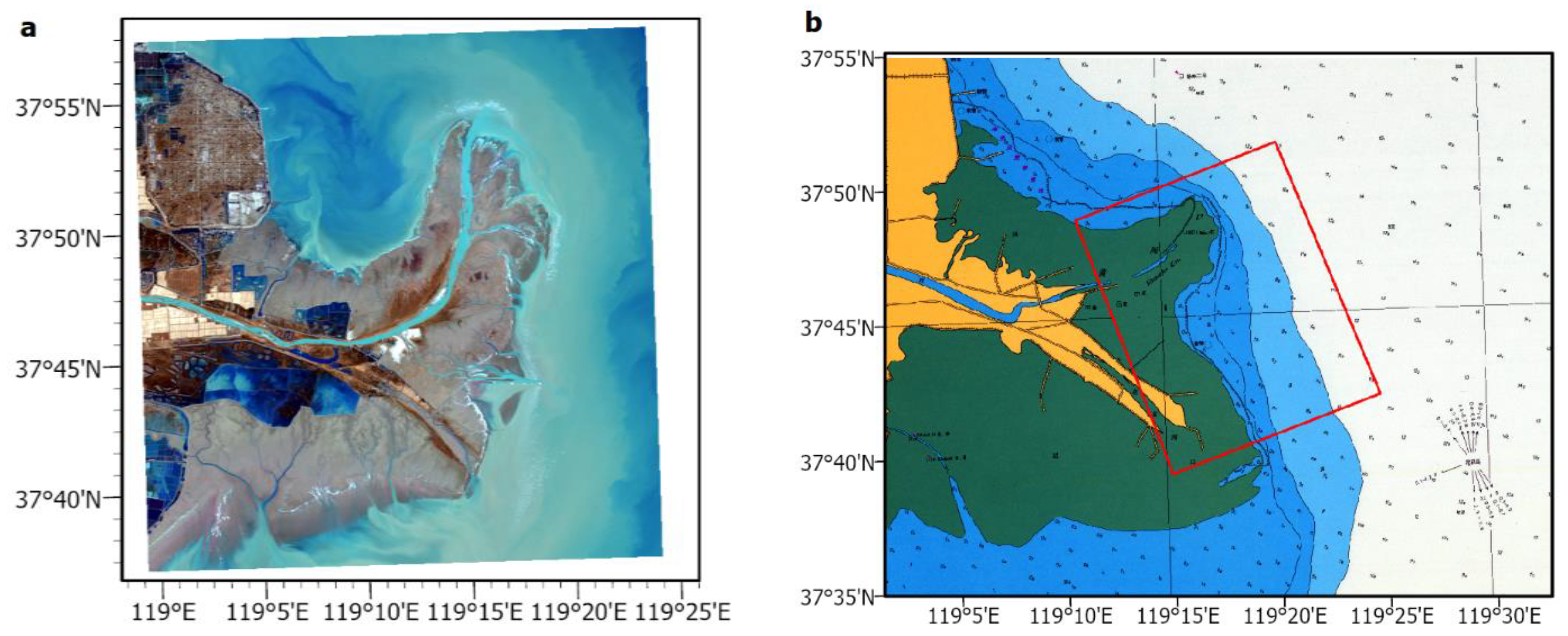
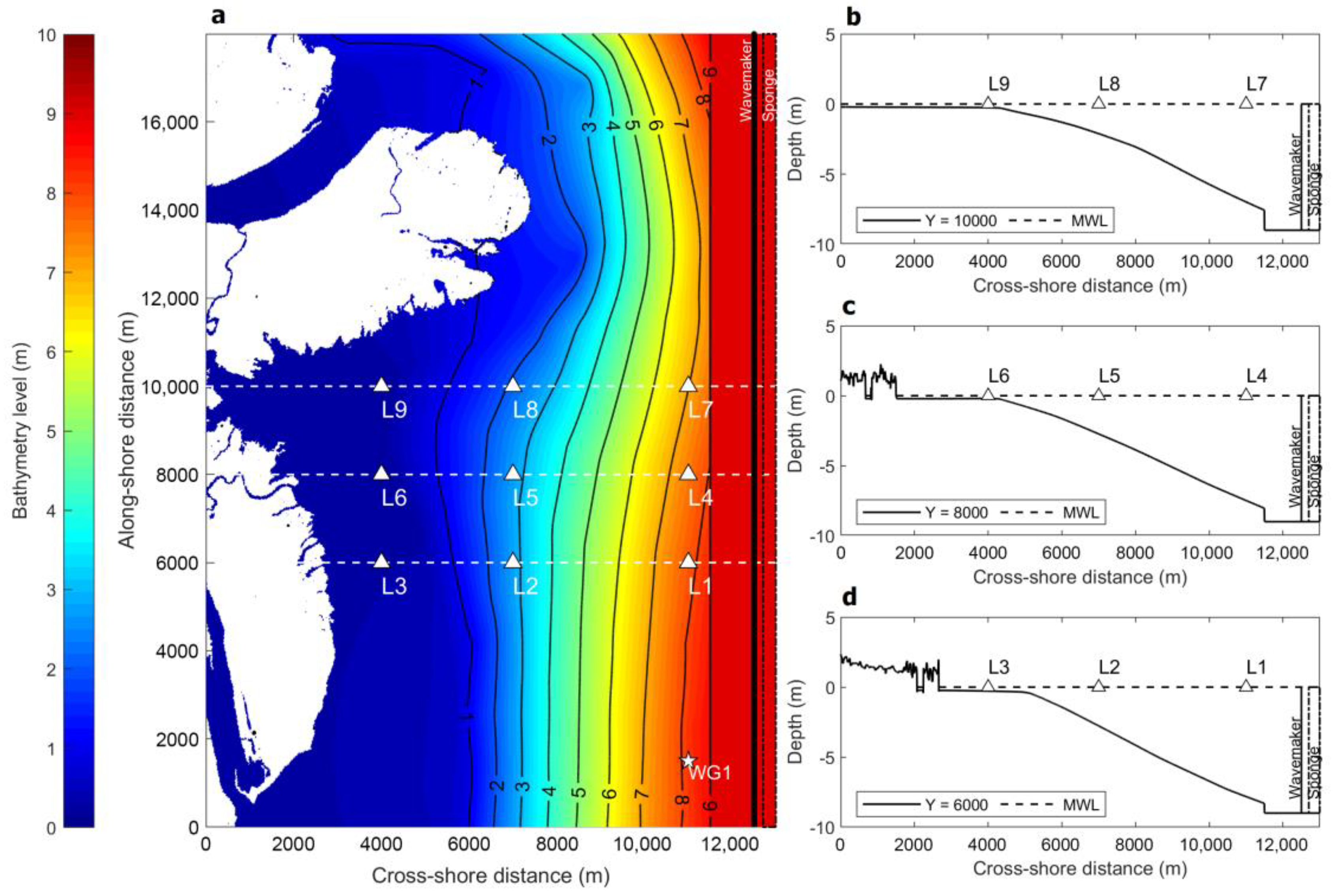

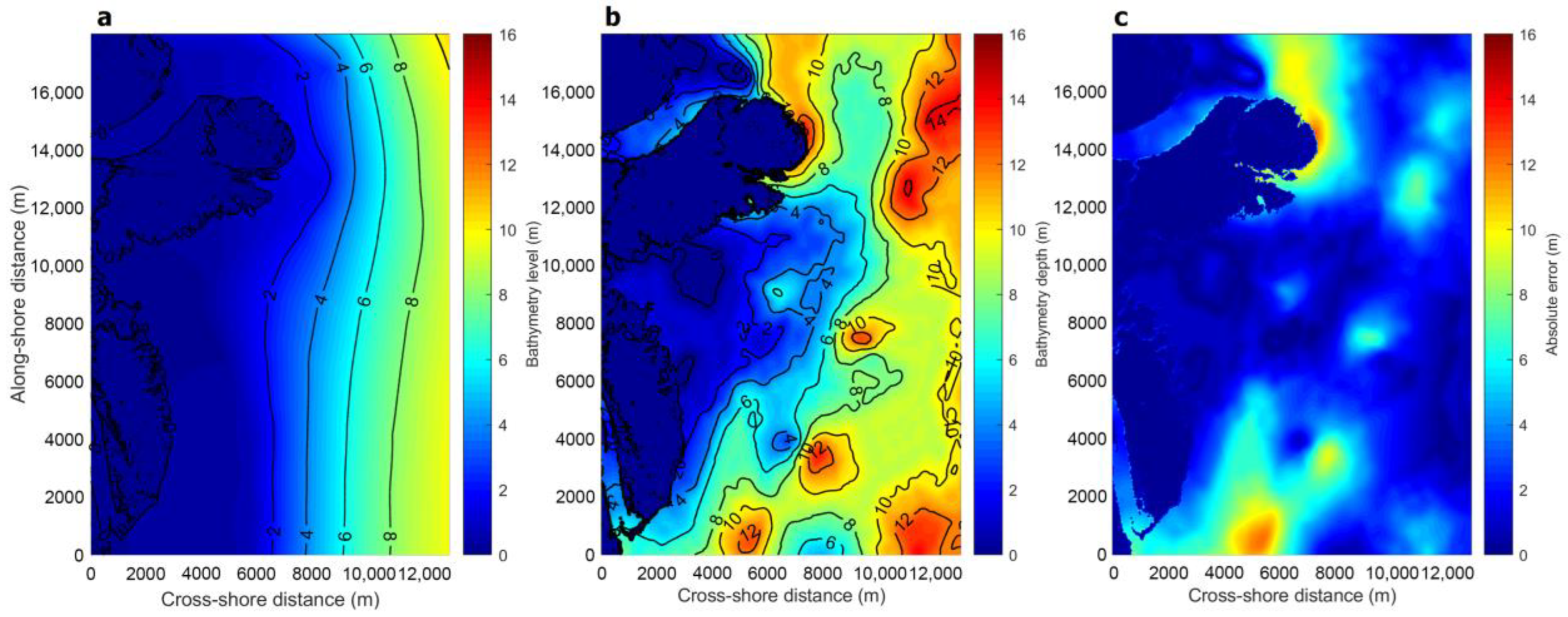

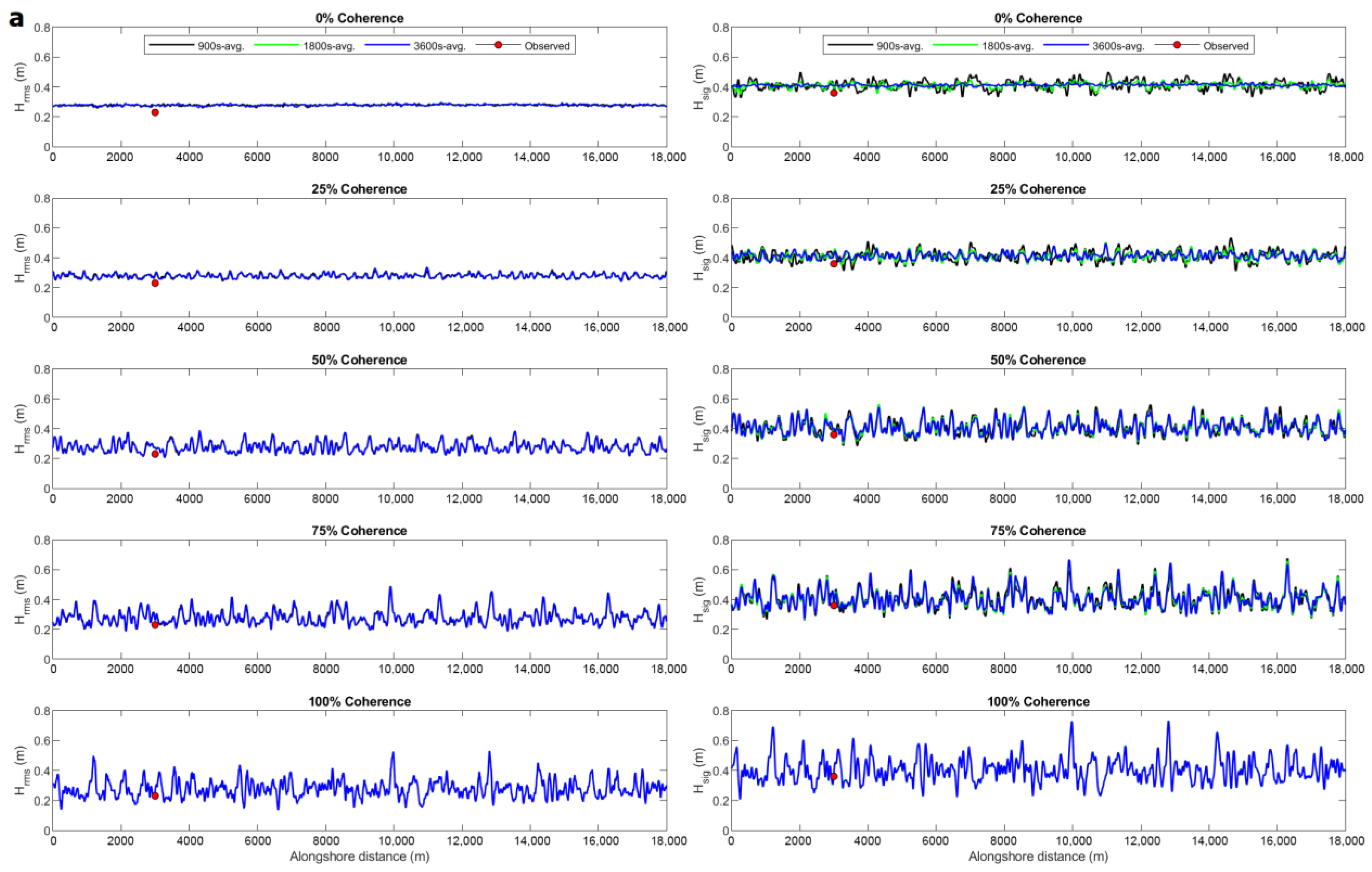
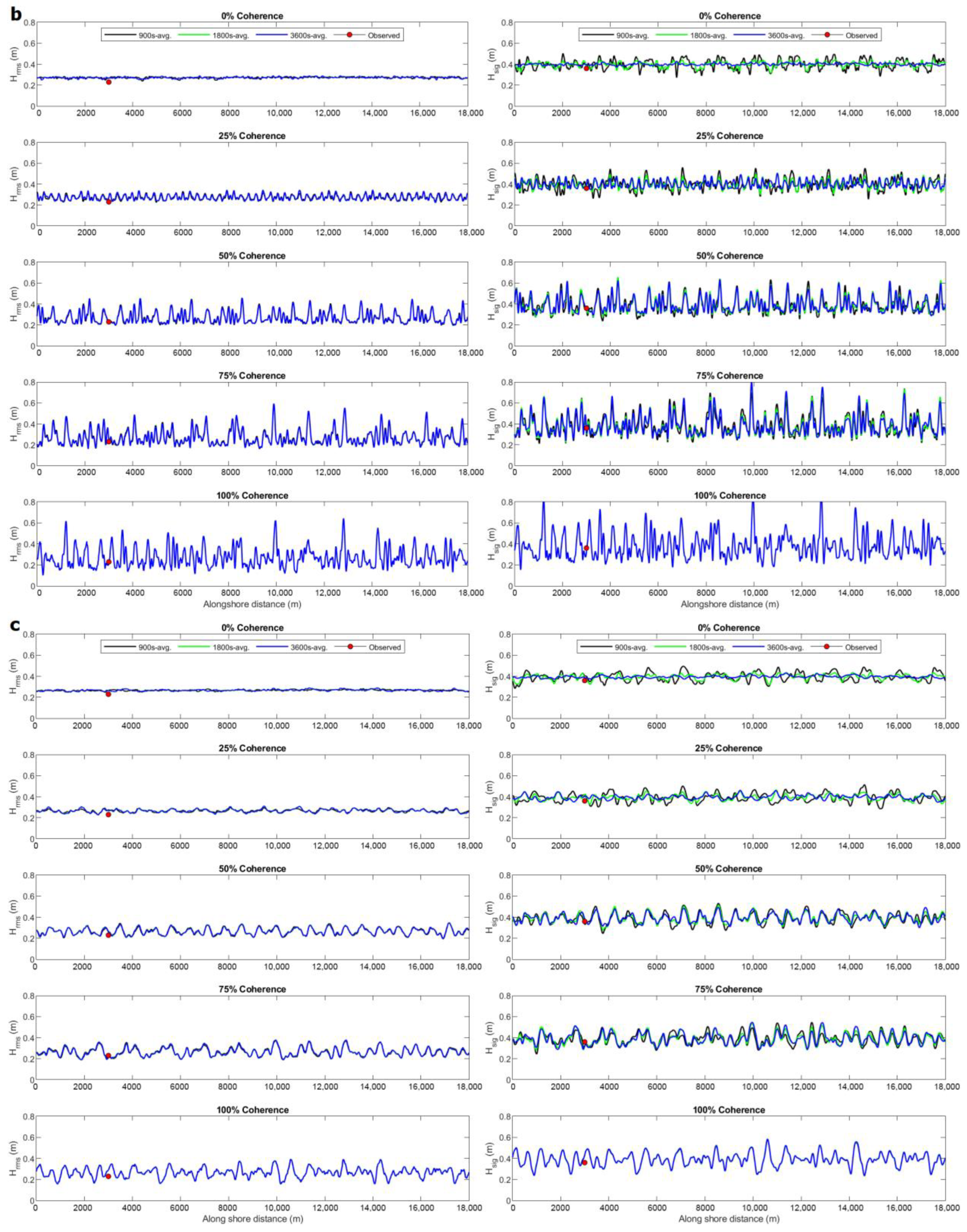
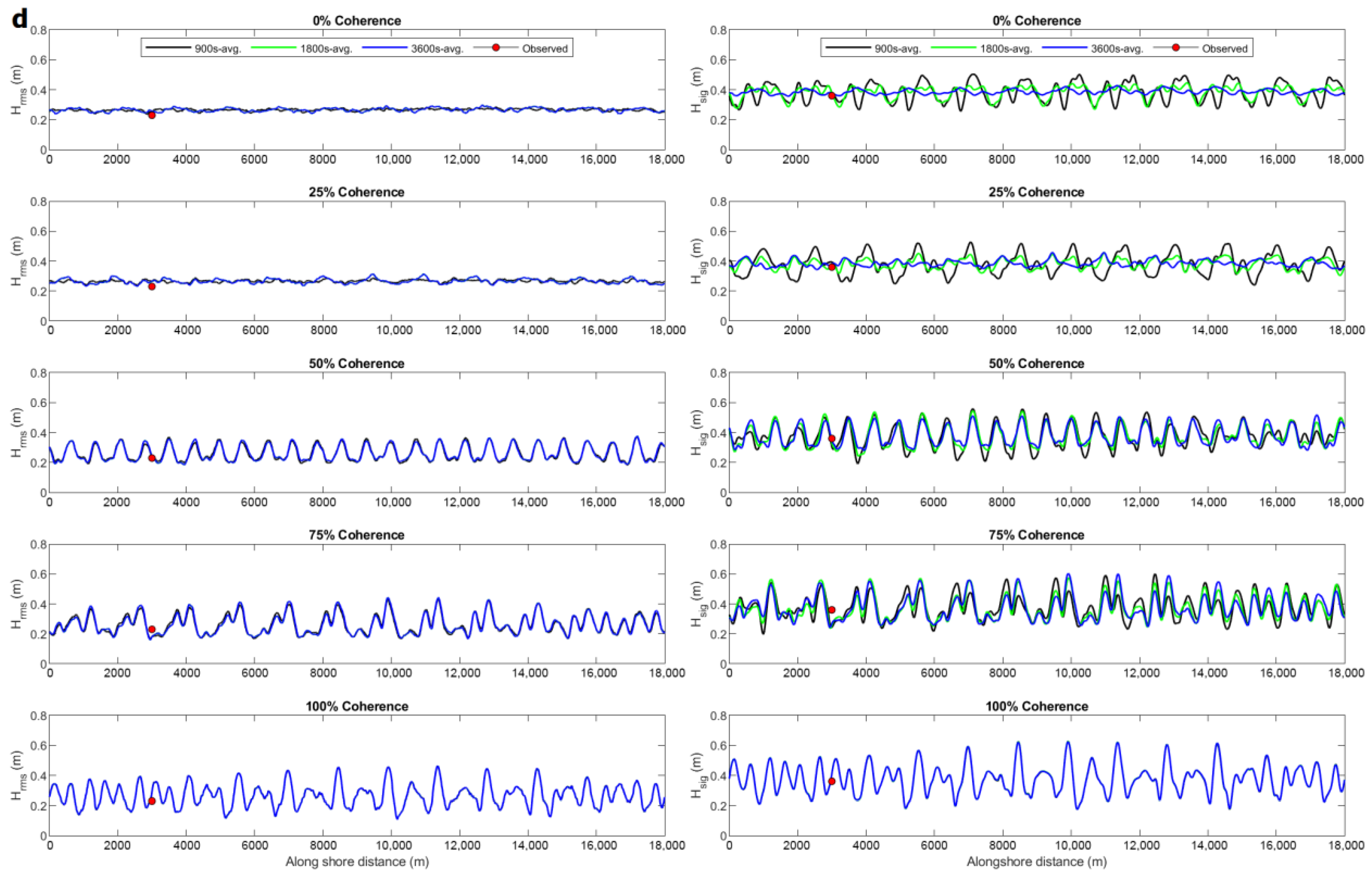
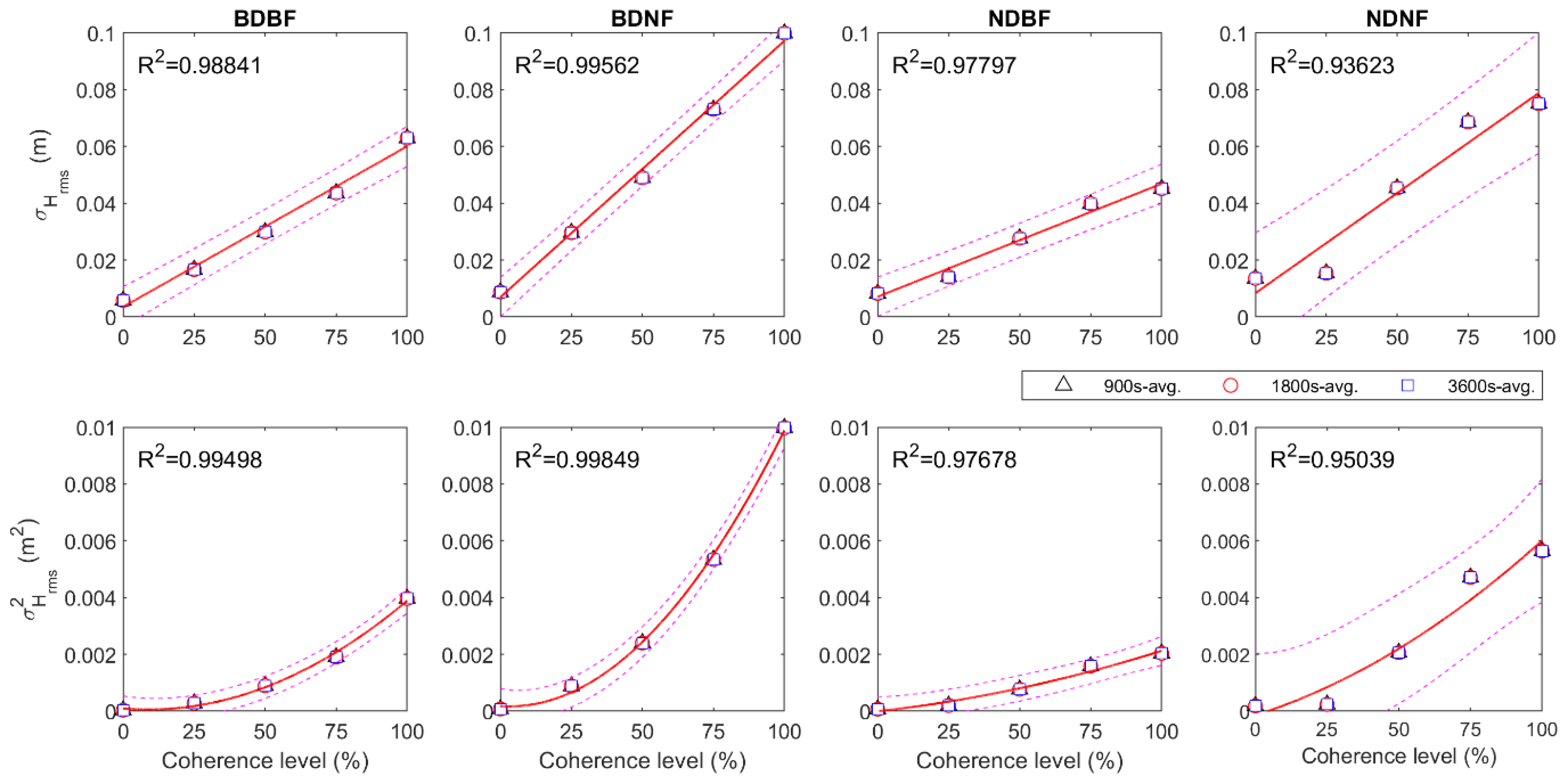

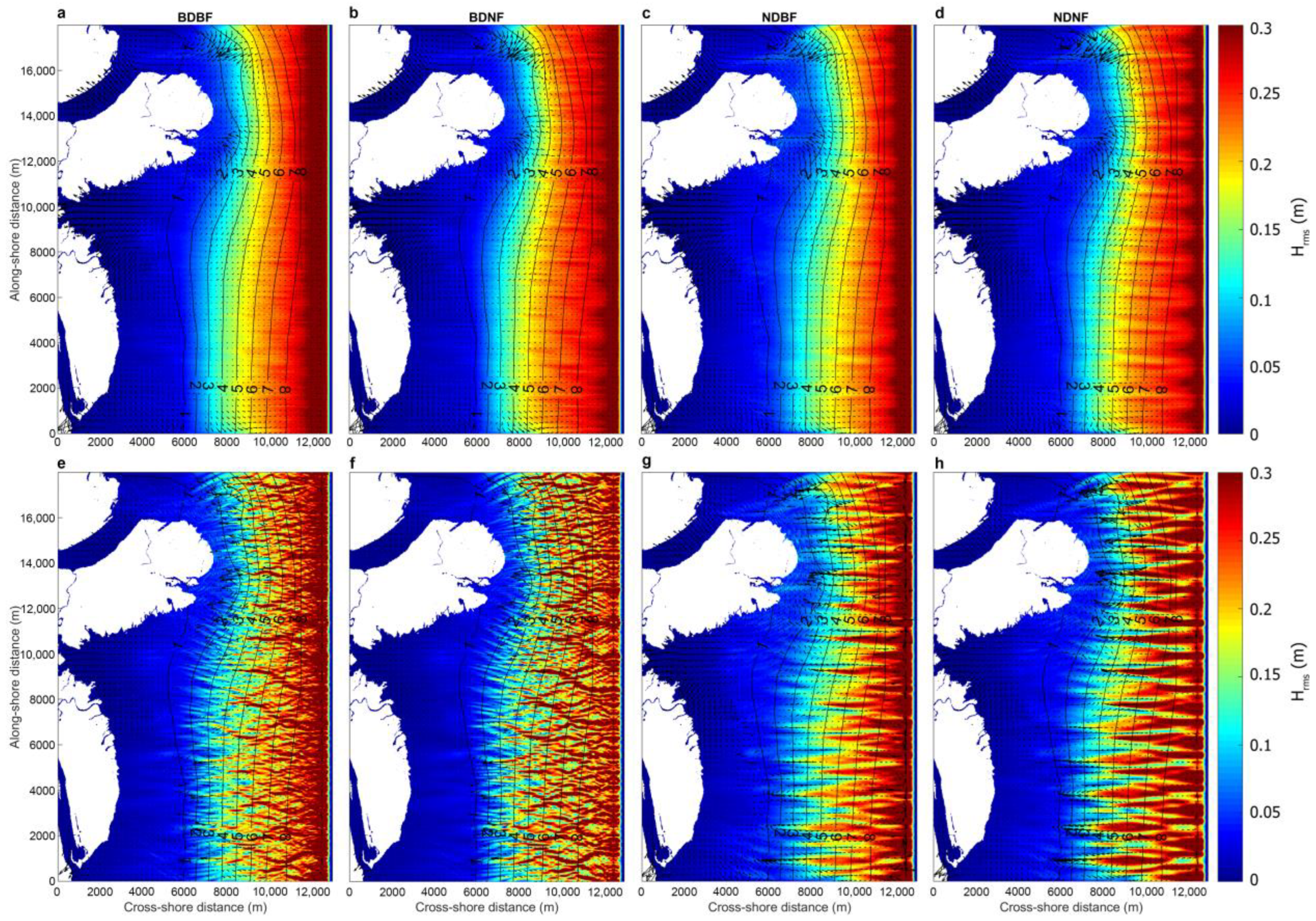
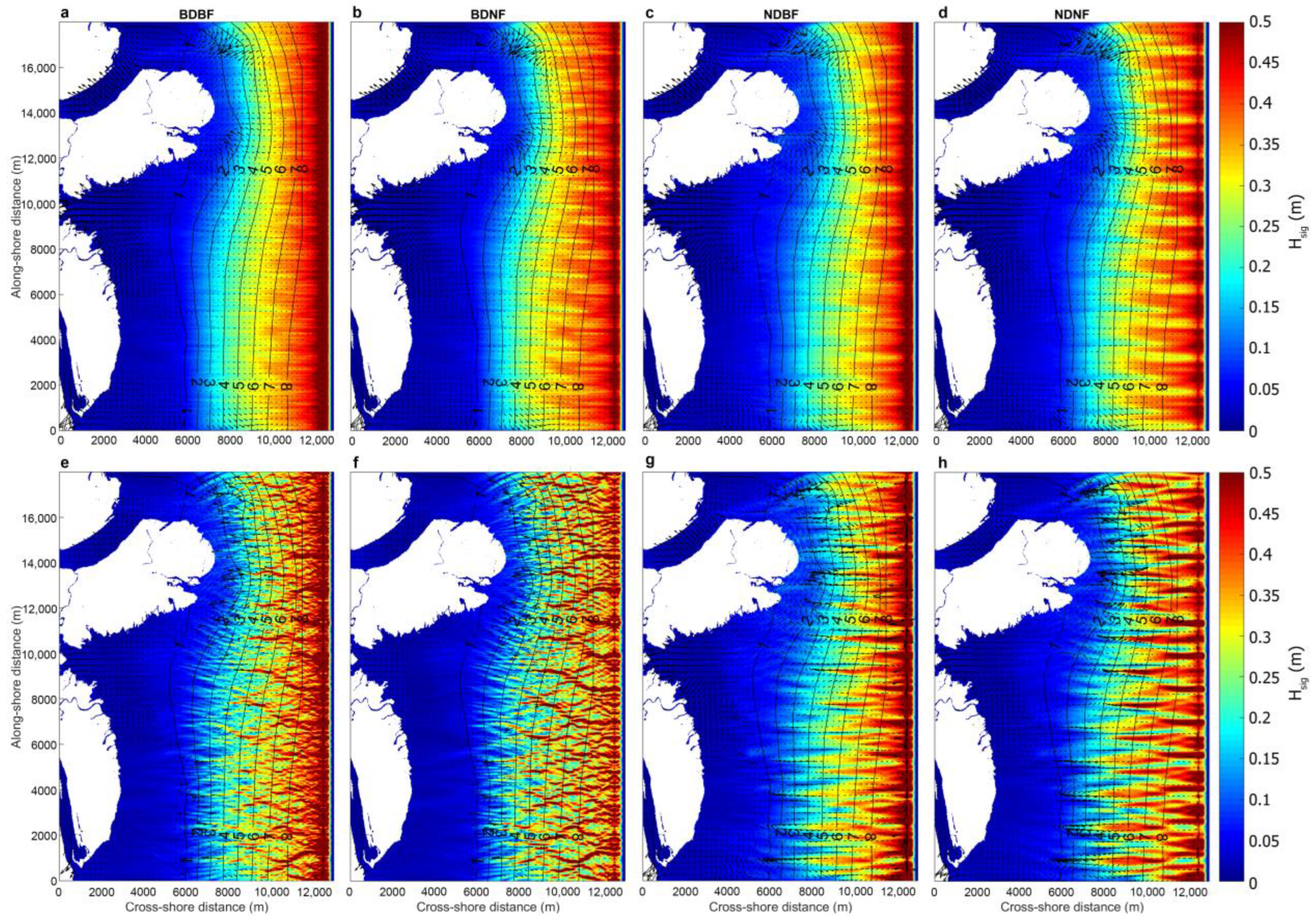
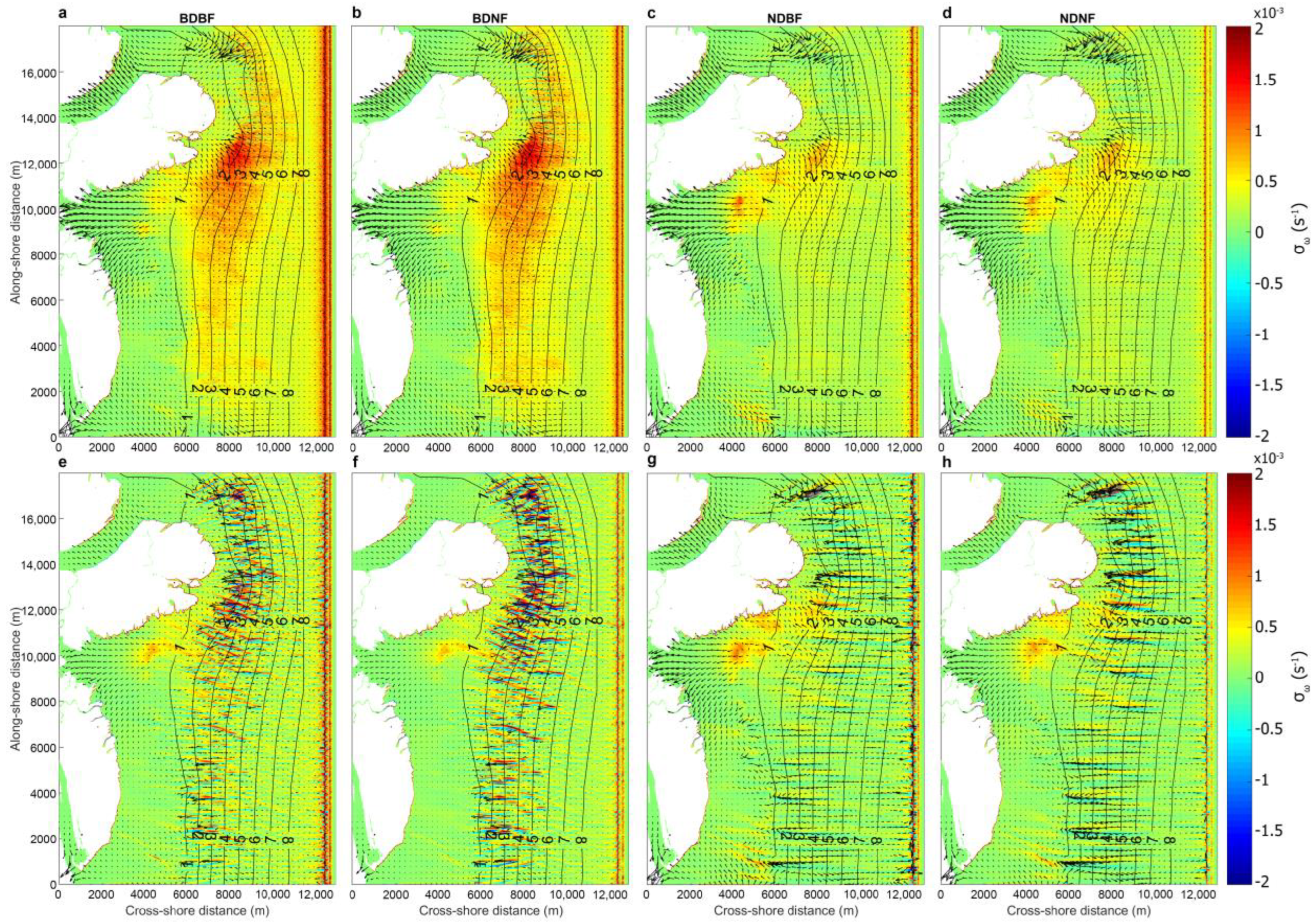
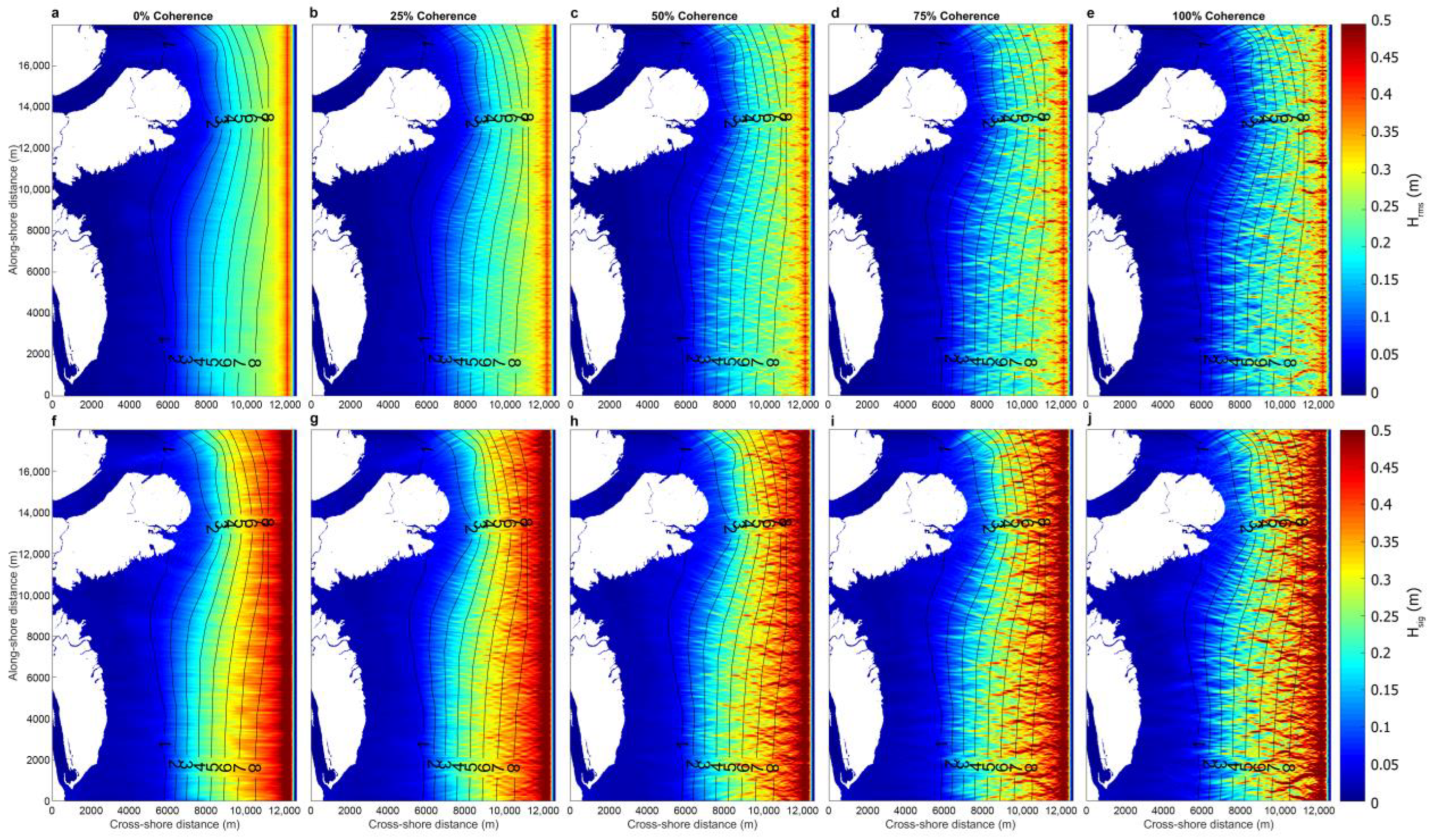
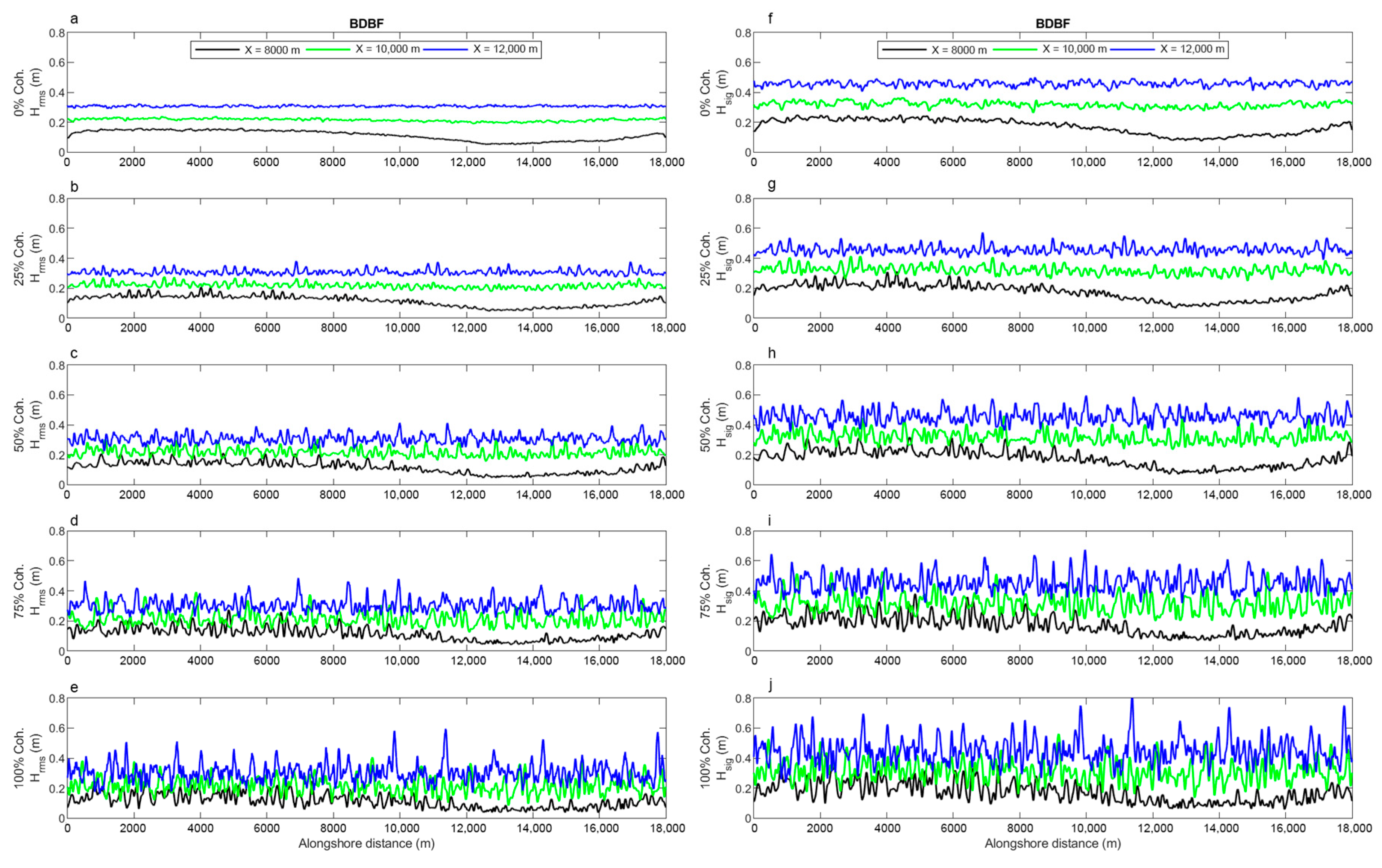
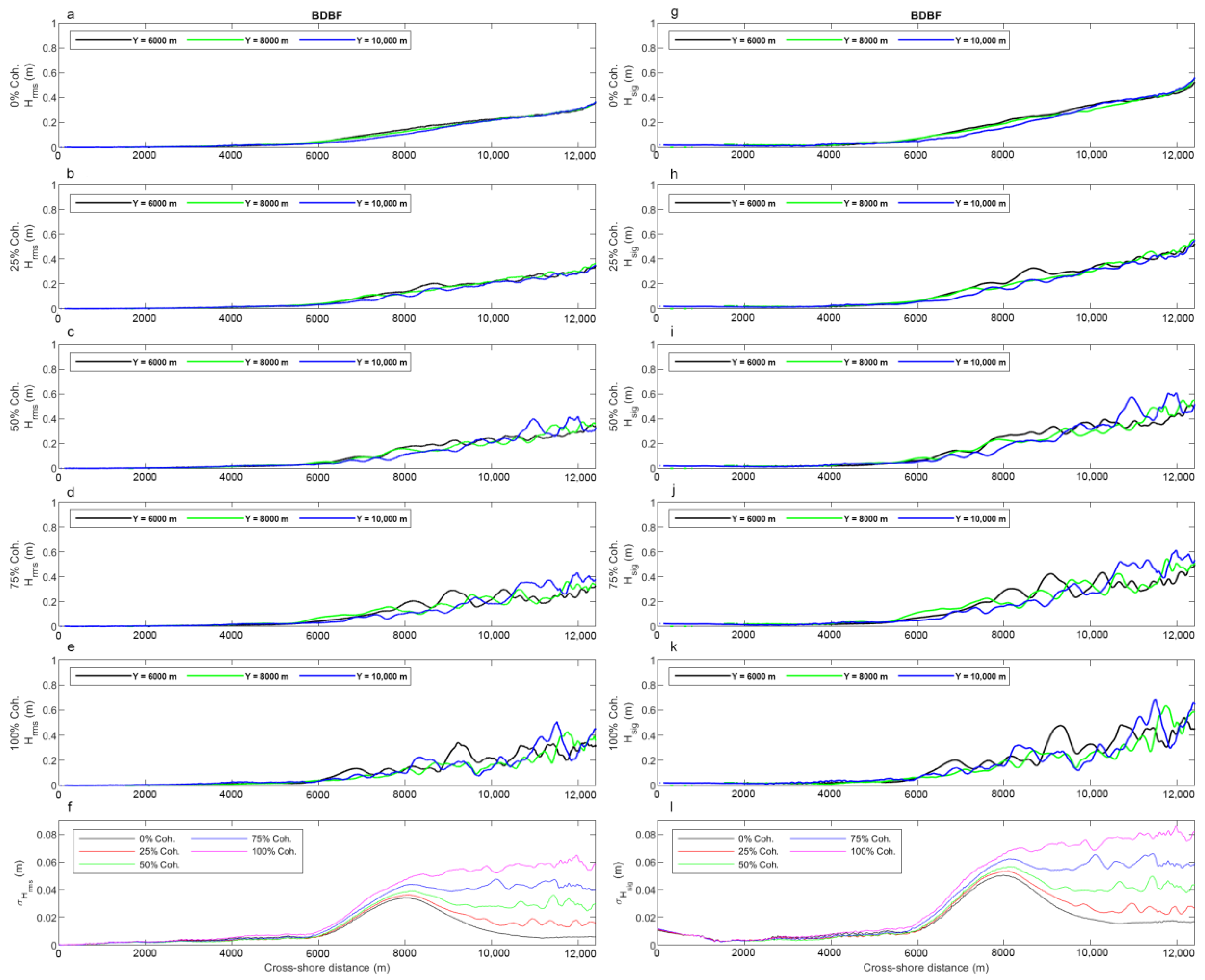

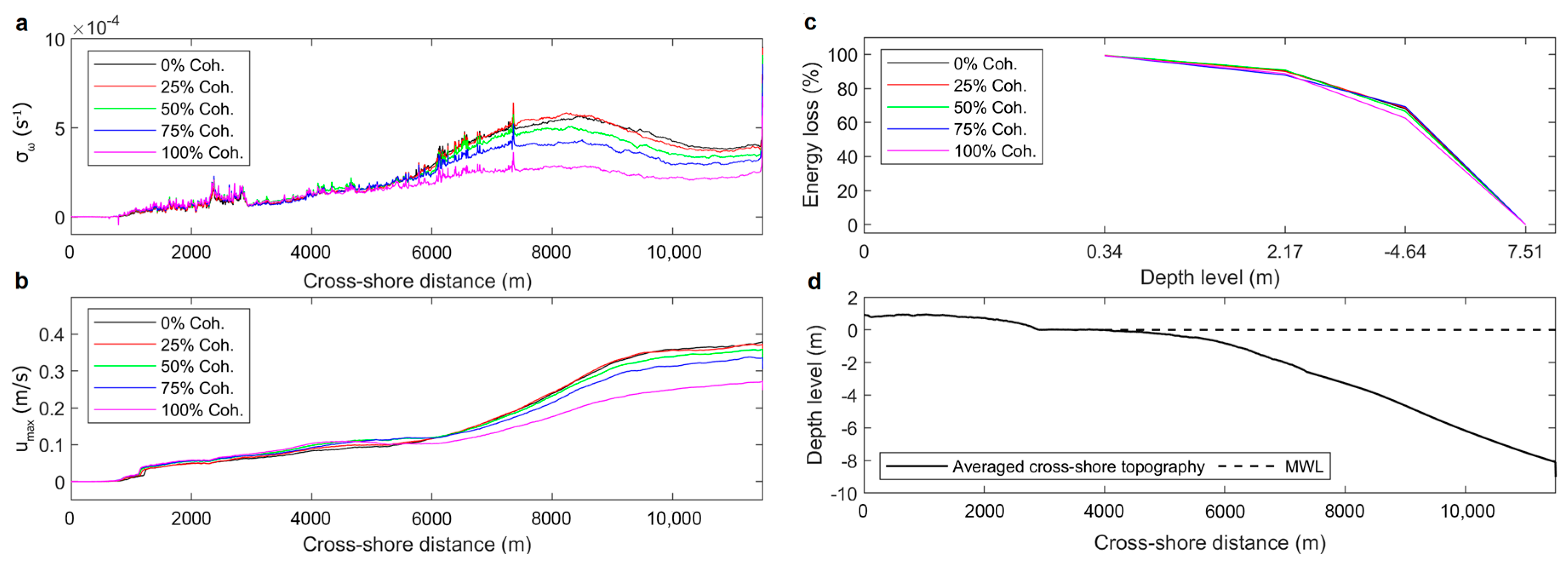
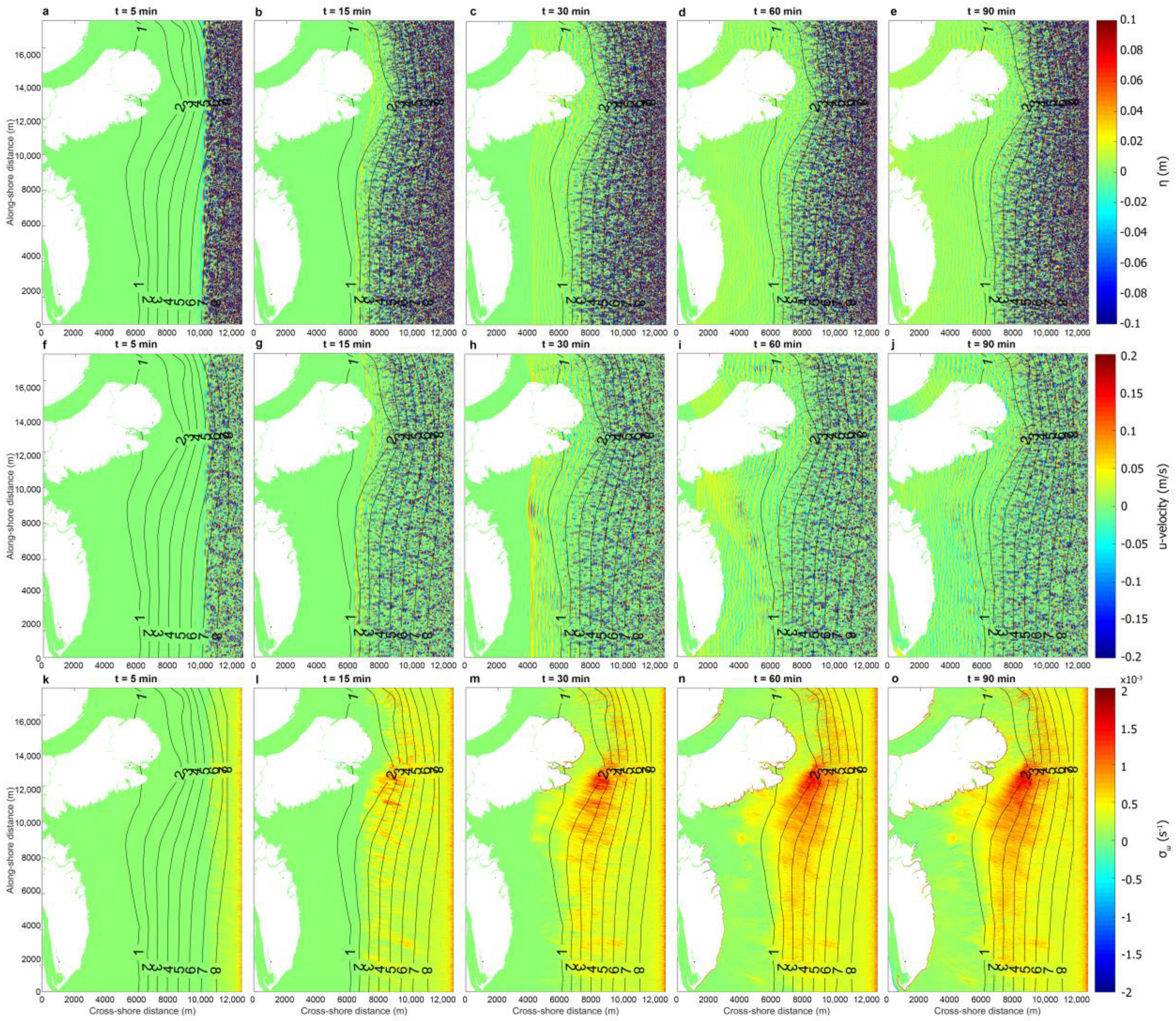
| Maps | NC50 | NC10 | NC5 | NC2 | GT50 | GT10 | GT5 | GT2 |
|---|---|---|---|---|---|---|---|---|
| Min | −11.785 | −11.815 | −11.792 | −11.795 | −15.132 | −15.214 | −16.042 | −16.316 |
| Max | 4.372 | 4.401 | 4.522 | 4.433 | 4.372 | 4.401 | 3.915 | 5.298 |
| Median | −2.169 | −2.223 | −2.171 | −2.173 | −6.918 | −6.976 | −6.942 | −6.949 |
| Mean | −3.496 | −3.538 | −3.503 | −3.505 | −5.795 | −5.871 | −5.829 | −5.833 |
| STD | 4.021 | 4.03 | 4.018 | 4.018 | 4.891 | 4.889 | 4.888 | 4.889 |
| Comparing with NC50 | Comparing with GT50 | |||||||
| Bias | - | 0.0411 | 0.0066 | 0.0083 | - | 0.0763 | 0.0346 | 0.0388 |
| Diff.Md | - | 0.0543 | 0.0016 | 0.0041 | - | 0.058 | 0.0242 | 0.0313 |
| MdAE | - | 0.0252 | 0.0306 | 0.0337 | - | 0.0878 | 0.0511 | 0.0255 |
| RMSE | - | 0.2945 | 0.2568 | 0.2656 | - | 0.8605 | 0.615 | 0.7166 |
| Maps | NC50 | NC10 | NC5 | NC2 | GT50 | GT10 | GT5 | GT2 |
|---|---|---|---|---|---|---|---|---|
| NC50 | 1 | |||||||
| NC10 | 0.9936 | 1 | ||||||
| NC5 | 0.998 | 0.9946 | 1 | |||||
| NC2 | 0.9979 | 0.9947 | 0.9992 | 1 | ||||
| GT50 | 0.8617 | 0.8512 | 0.8545 | 0.8538 | 1 | |||
| GT10 | 0.8561 | 0.8547 | 0.8547 | 0.8545 | 0.9846 | 1 | ||
| GT5 | 0.8594 | 0.8539 | 0.8575 | 0.8566 | 0.9921 | 0.9908 | 1 | |
| GT2 | 0.8579 | 0.8535 | 0.8568 | 0.8573 | 0.9892 | 0.9913 | 0.9958 | 1 |
| Pairs | NC50 vs. GT50 | NC10 vs. GT10 | NC5 vs. GT5 | NC2 vs. GT2 |
|---|---|---|---|---|
| Bias | 2.2982 | 2.3334 | 2.3262 | 2.3287 |
| Diff.Md | 4.7487 | 4.7524 | 4.7713 | 4.7759 |
| MdAE | 1.6178 | 1.6678 | 1.6753 | 1.6608 |
| RMSE | 3.388 | 3.4247 | 3.4188 | 3.4157 |
Disclaimer/Publisher’s Note: The statements, opinions and data contained in all publications are solely those of the individual author(s) and contributor(s) and not of MDPI and/or the editor(s). MDPI and/or the editor(s) disclaim responsibility for any injury to people or property resulting from any ideas, methods, instructions or products referred to in the content. |
© 2023 by the authors. Licensee MDPI, Basel, Switzerland. This article is an open access article distributed under the terms and conditions of the Creative Commons Attribution (CC BY) license (https://creativecommons.org/licenses/by/4.0/).
Share and Cite
Nguyen, Q.T.; Mao, M.; Xia, M. Numerical Modeling of Nearshore Wave Transformation and Breaking Processes in the Yellow River Delta with FUNWAVE-TVD Wave Model. J. Mar. Sci. Eng. 2023, 11, 1380. https://doi.org/10.3390/jmse11071380
Nguyen QT, Mao M, Xia M. Numerical Modeling of Nearshore Wave Transformation and Breaking Processes in the Yellow River Delta with FUNWAVE-TVD Wave Model. Journal of Marine Science and Engineering. 2023; 11(7):1380. https://doi.org/10.3390/jmse11071380
Chicago/Turabian StyleNguyen, Quan Trong, Miaohua Mao, and Meng Xia. 2023. "Numerical Modeling of Nearshore Wave Transformation and Breaking Processes in the Yellow River Delta with FUNWAVE-TVD Wave Model" Journal of Marine Science and Engineering 11, no. 7: 1380. https://doi.org/10.3390/jmse11071380





